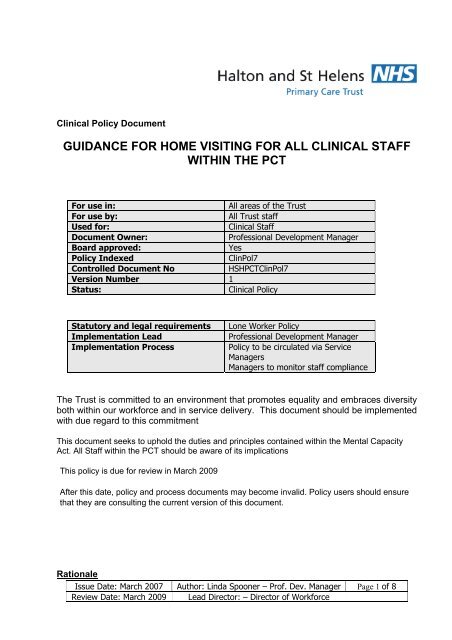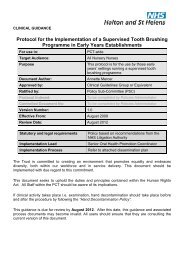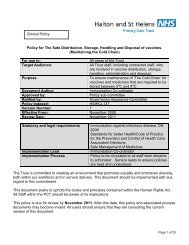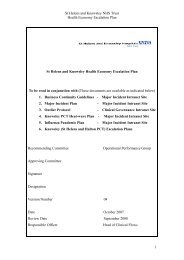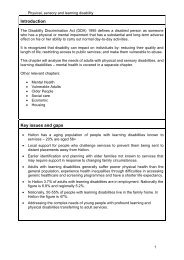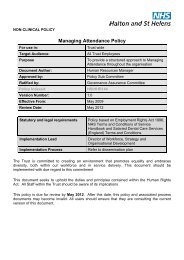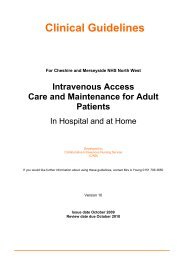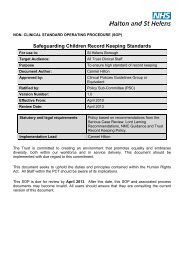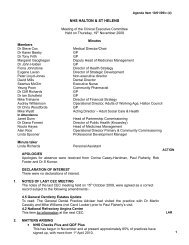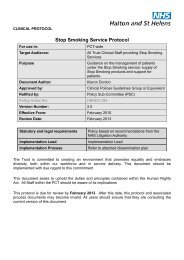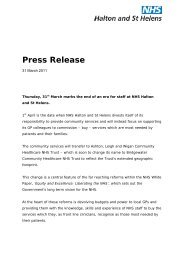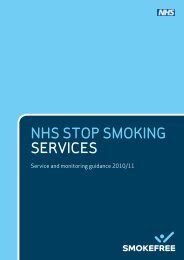guidance for home visiting for all clinical staff within the pct
guidance for home visiting for all clinical staff within the pct
guidance for home visiting for all clinical staff within the pct
Create successful ePaper yourself
Turn your PDF publications into a flip-book with our unique Google optimized e-Paper software.
Clinical Policy Document<br />
GUIDANCE FOR HOME VISITING FOR ALL CLINICAL STAFF<br />
WITHIN THE PCT<br />
For use in: All areas of <strong>the</strong> Trust<br />
For use by: All Trust <strong>staff</strong><br />
Used <strong>for</strong>: Clinical Staff<br />
Document Owner: Professional Development Manager<br />
Board approved: Yes<br />
Policy Indexed ClinPol7<br />
Controlled Document No HSHPCTClinPol7<br />
Version Number 1<br />
Status: Clinical Policy<br />
Statutory and legal requirements Lone Worker Policy<br />
Implementation Lead Professional Development Manager<br />
Implementation Process Policy to be circulated via Service<br />
Managers<br />
Managers to monitor <strong>staff</strong> compliance<br />
The Trust is committed to an environment that promotes equality and embraces diversity<br />
both <strong>within</strong> our work<strong>for</strong>ce and in service delivery. This document should be implemented<br />
with due regard to this commitment<br />
This document seeks to uphold <strong>the</strong> duties and principles contained <strong>within</strong> <strong>the</strong> Mental Capacity<br />
Act. All Staff <strong>within</strong> <strong>the</strong> PCT should be aware of its implications<br />
This policy is due <strong>for</strong> review in March 2009<br />
After this date, policy and process documents may become invalid. Policy users should ensure<br />
that <strong>the</strong>y are consulting <strong>the</strong> current version of this document.<br />
Rationale<br />
Issue Date: March 2007 Author: Linda Spooner – Prof. Dev. Manager Page 1 of 8<br />
Review Date: March 2009 Lead Director: – Director of Work<strong>for</strong>ce
This procedure is to help <strong>staff</strong> understand <strong>the</strong>ir responsibilities when <strong>visiting</strong> clients at<br />
<strong>home</strong>.<br />
It is also intended to provide some advice to <strong>staff</strong> who may find <strong>the</strong>mselves in a difficult<br />
situation and to offer support to <strong>staff</strong> who by <strong>the</strong> very nature of <strong>the</strong>ir roles, work out in <strong>the</strong><br />
community, often entering into unknown situations.<br />
The PCT has a duty of care to provide health services to <strong>the</strong> population of Halton and St<br />
Helens; however, this does not mean <strong>staff</strong> have to accept inappropriate<br />
behaviour/manner being displayed.<br />
Staff must use <strong>the</strong>ir professional knowledge, and to take some personal responsibility <strong>for</strong><br />
<strong>the</strong>ir own safety.<br />
Whe<strong>the</strong>r <strong>staff</strong> work daily, or infrequently in patients <strong>home</strong>s <strong>all</strong> <strong>staff</strong> should ensure that<br />
<strong>the</strong>y familiarise <strong>the</strong>mselves with this procedure.<br />
Issue Date: March 2007 Author: Linda Spooner – Prof. Dev. Manager Page 2 of 8<br />
Review Date: March 2009 Lead Director: – Director of Work<strong>for</strong>ce
Guidelines <strong>for</strong> Home Visiting<br />
ACTION RATIONALE<br />
Staff to adhere to <strong>the</strong>ir service<br />
specification on criteria <strong>for</strong> <strong>home</strong> visits.<br />
Visits where possible should be planned<br />
a minimum of one day ahead.<br />
An inventory of proposed visits must be<br />
kept in a paper diary and a copy left in<br />
<strong>the</strong> office.<br />
Staff must report back into base after<br />
<strong>the</strong> last visit of <strong>the</strong> day. If this is not<br />
possible, <strong>the</strong>n <strong>the</strong> Team Leader or<br />
ano<strong>the</strong>r team member should be aware<br />
where <strong>the</strong> last visit of <strong>the</strong> day is taking<br />
place and <strong>the</strong> intention of <strong>the</strong> <strong>staff</strong><br />
member to go <strong>home</strong> from that point.<br />
If <strong>staff</strong> are expected back at base and<br />
are delayed, every ef<strong>for</strong>t should be<br />
made to contact <strong>the</strong>ir base with this<br />
in<strong>for</strong>mation.<br />
Managers/Team Leaders should keep a<br />
list of make, colour and registration<br />
number of <strong>all</strong> <strong>staff</strong> cars, which should be<br />
kept up-to-date.<br />
Staff must keep a record of <strong>all</strong> daily<br />
visits in a diary.<br />
Where possible, contact client/patient to<br />
indicate visit date and time.<br />
Introduce yourself on <strong>the</strong> door step and<br />
show your identity card which should be<br />
worn at <strong>all</strong> times.<br />
Identify that you have <strong>the</strong> correct<br />
client/patient.<br />
Explain <strong>the</strong> reason <strong>for</strong> your visit, and<br />
who referred you to <strong>the</strong> client/patient.<br />
To make appropriate use of health<br />
professionals time.<br />
To ensure a correct inventory of visits<br />
can be kept.<br />
Staff whereabouts can be identified in<br />
case of an emergency.<br />
Safeguard <strong>the</strong> member of <strong>staff</strong>.<br />
To ensure safety of <strong>staff</strong> and prevent<br />
any unnecessary concerns.<br />
To enable a quick source reference in<br />
<strong>the</strong> event of an incident occurring,<br />
should o<strong>the</strong>r services need <strong>the</strong><br />
in<strong>for</strong>mation.<br />
For audit and activity purposes.<br />
Good client/patient communication.<br />
Patient safety.<br />
To ensure client/patient receives<br />
correct treatment.<br />
In<strong>for</strong>med consent.<br />
Issue Date: March 2007 Author: Linda Spooner – Prof. Dev. Manager Page 3 of 8<br />
Review Date: March 2009 Lead Director: – Director of Work<strong>for</strong>ce
ACTION RATIONALE<br />
Be<strong>for</strong>e leaving, leave your full name<br />
and contact number and notification of<br />
any future visits. Ensure client/patient<br />
understands future care plan.<br />
Ensure that <strong>the</strong> date and time of next<br />
visit is suitable <strong>for</strong> <strong>the</strong> client/patient.<br />
Ask <strong>the</strong> client/patient to in<strong>for</strong>m your<br />
base if <strong>the</strong> appointment becomes<br />
inappropriate.<br />
If patient/client is expecting you, as in a<br />
regular pattern and you cannot gain<br />
access:-<br />
Knock loudly<br />
Knock on window<br />
Check through <strong>the</strong> window <strong>for</strong> signs<br />
that <strong>the</strong> client is in, eg inner doors<br />
open, fire on.<br />
If appropriate, knock at adjoining house<br />
to check if neighbour has seen or heard<br />
patient/client.<br />
If you are concerned and you feel that<br />
<strong>the</strong> patient/client is in <strong>the</strong> house, ei<strong>the</strong>r<br />
contact Social Services or o<strong>the</strong>r<br />
agencies that have key access or<br />
contact <strong>the</strong> police.<br />
If you are concerned that a child/young<br />
person is in <strong>the</strong> <strong>home</strong> inappropriately<br />
alone/unsupervised contact <strong>the</strong><br />
Halton CSC Duty Officer straight away<br />
to make a child protection referral and<br />
complete <strong>the</strong> appropriate referral <strong>for</strong>m<br />
<strong>within</strong> 24 hours in line with Halton<br />
LSCB Child Protection Procedures.<br />
Contact your manager and <strong>the</strong> child<br />
protection manager to discuss your<br />
observations or to seek immediate<br />
advice from <strong>the</strong>m if you are uncertain<br />
whe<strong>the</strong>r <strong>the</strong> child is<br />
alone/unsupervised.<br />
To ensure client/patient is fully<br />
in<strong>for</strong>med and participating in <strong>the</strong>ir care.<br />
To avoid failed visits.<br />
To avoid failed visits.<br />
To ensure patient/client is not at <strong>home</strong>.<br />
To ascertain if patient/client may be at<br />
risk.<br />
To ensure patient/client safety.<br />
To ensure that children/young people<br />
are protected and that child protection<br />
procedures are complied with.<br />
Issue Date: March 2007 Author: Linda Spooner – Prof. Dev. Manager Page 4 of 8<br />
Review Date: March 2009 Lead Director: – Director of Work<strong>for</strong>ce
ACTION RATIONALE<br />
If you feel <strong>the</strong> patient/client is not at<br />
<strong>home</strong>, leave a card to say you have<br />
c<strong>all</strong>ed and ask patient/client to contact<br />
you. Document in records and arrange<br />
a fur<strong>the</strong>r appointment if necessary.<br />
Where it is unusual <strong>for</strong> <strong>the</strong> patient not<br />
to be in, discuss with your<br />
manager/Team Leader on return to<br />
base.<br />
Ensure that you do not display any sign<br />
in your car that you are a Health<br />
Worker.<br />
Always ensure you have easy access<br />
to your Personal Attack Alarm or<br />
mobile.<br />
Avoid dark <strong>all</strong>eys – doorways or lonely<br />
areas especi<strong>all</strong>y after dark<br />
Carry loose change <strong>for</strong> <strong>the</strong> telephone or<br />
have a mobile phone with you<br />
Carry cards to post if patient is not at<br />
<strong>home</strong>.<br />
Ensure that <strong>all</strong> personal belongings etc<br />
are kept out of sight in your car.<br />
Do not carry any valuables with you.<br />
Patients records and treatment cards<br />
should not be left in cars unless<br />
secured in <strong>the</strong> boot of <strong>the</strong> car, and<br />
should not be left in car boot overnight.<br />
Nursing bags should be taken into <strong>the</strong><br />
patients <strong>home</strong>, or locked in <strong>the</strong> car<br />
boot.<br />
Always plan your route – know where<br />
you are going.<br />
Make sure your car is in good working<br />
To ensure effective use of clinician’s<br />
time.<br />
To ensure patient is not at risk.<br />
This does not provide any special<br />
entitlement to parking etc. and could<br />
make you and your car vulnerable to<br />
attack.<br />
To ensure <strong>staff</strong> safety<br />
To ensure <strong>staff</strong> safety<br />
In case of emergency<br />
To ensure patient/client is aware that<br />
you have c<strong>all</strong>ed.<br />
To prevent risk of break in.<br />
To prevent risk of loss/<strong>the</strong>ft.<br />
To prevent unauthorised access to<br />
in<strong>for</strong>mation.<br />
To prevent risk of <strong>the</strong>ft.<br />
To minimise risk to <strong>staff</strong>.<br />
To minimise breakdown.<br />
Issue Date: March 2007 Author: Linda Spooner – Prof. Dev. Manager Page 5 of 8<br />
Review Date: March 2009 Lead Director: – Director of Work<strong>for</strong>ce
order and has enough petrol in tank.<br />
ACTION RATIONALE<br />
Park your car in a safe and well lit place<br />
that also <strong>all</strong>ows safe access to your<br />
destination.<br />
Always lock your vehicle.<br />
Records/nursing bag must not be left in<br />
your car overnight. Every attempt<br />
should be made to return<br />
records/nursing bag to base, however,<br />
if not returning to base, bag must be<br />
stored safely in own <strong>home</strong>.<br />
Staff are advised to be a member of a<br />
recovery service and c<strong>all</strong> as<br />
appropriate ie RAC/AA/Garage<br />
If car does breakdown, contact base to<br />
in<strong>for</strong>m of situation<br />
In <strong>the</strong> event of a breakdown ask base<br />
to contact patient/clients to in<strong>for</strong>m of<br />
delay<br />
In severe wea<strong>the</strong>r conditions do not<br />
take risks, seek advice from your<br />
Manager/Team Leader be<strong>for</strong>e planning<br />
visits and visit urgent cases on foot if<br />
possible.<br />
If you cancel visits due to <strong>the</strong> wea<strong>the</strong>r,<br />
in<strong>for</strong>m your Manager and ring patients<br />
where possible.<br />
To minimise risk to car and <strong>staff</strong>.<br />
To minimise risk of <strong>the</strong>ft.<br />
To prevent unauthorised access to<br />
patient in<strong>for</strong>mation and ensure patient<br />
safety.<br />
To ensure prompt response to <strong>the</strong><br />
breakdown.<br />
Can re-<strong>all</strong>ocate <strong>home</strong> <strong>visiting</strong> <strong>within</strong><br />
service.<br />
Patients/clients are in<strong>for</strong>med of<br />
cancelled or delayed visit.<br />
To minimise risks to <strong>staff</strong>.<br />
Minimise disruption to service and<br />
keep patients fully in<strong>for</strong>med.<br />
IN CASES WHERE A MEMBER OF STAFF IS LEFT FEELING VULNERABLE DUE<br />
TO VERBAL, PHYSICAL OR AGGRESSIVE BEHAVIOUR OR WHERE ACTIONS<br />
OF THE CLIENT OR OTHER MEMBER OF THE HOUSEHOLD ARE DISPLAYED<br />
IN A SEXUAL OR INAPPROPRIATE MANNER<br />
THE STAFF SHOULD:-<br />
Assess <strong>the</strong> situation carefully.<br />
To ensure correct procedure is<br />
followed.<br />
Consider <strong>the</strong>ir own personal safety. Personal safety is paramount.<br />
Be aware of <strong>the</strong> exit routes from <strong>the</strong> To secure own personal safety.<br />
Issue Date: March 2007 Author: Linda Spooner – Prof. Dev. Manager Page 6 of 8<br />
Review Date: March 2009 Lead Director: – Director of Work<strong>for</strong>ce
premises and leave.<br />
In<strong>for</strong>m <strong>the</strong>ir Manager immediately.<br />
To make PCT aware of <strong>the</strong> situation.<br />
ACTION RATIONALE<br />
Report situation on Accident/Incident<br />
<strong>for</strong>m.<br />
To ensure risk of situation is identified.<br />
In<strong>for</strong>m o<strong>the</strong>r colleagues who may be<br />
due to visit.<br />
After undertaking a risk assessment, if<br />
patient/client’s <strong>home</strong> is deemed<br />
unsuitable <strong>for</strong> <strong>the</strong> care required, an<br />
alternative should be sought wherever<br />
possible.<br />
If fur<strong>the</strong>r visits are essential eg<br />
seriously ill patient, <strong>the</strong> Risk Manager<br />
and manager will undertake a risk<br />
assessment and determine if and how<br />
<strong>the</strong> service will continue (following lone<br />
worker <strong>guidance</strong>).<br />
To prevent o<strong>the</strong>r <strong>staff</strong> going into <strong>the</strong><br />
situation.<br />
To ensure procedure is followed as<br />
<strong>the</strong>re is a duty of care to <strong>the</strong><br />
patient/client as well as to <strong>staff</strong>.<br />
To ensure <strong>staff</strong> safety.<br />
When <strong>staff</strong> are aware that <strong>the</strong>y will be <strong>visiting</strong> a <strong>home</strong> where <strong>the</strong>re is an animal, eg<br />
dog, about which <strong>the</strong>y have a concern, <strong>the</strong> following procedure should be adopted:<br />
If possible, telephone <strong>the</strong> patient/client,<br />
giving an approximate time of <strong>visiting</strong><br />
and requesting that <strong>the</strong> animal be<br />
removed/locked up away from <strong>the</strong> area<br />
of treatment be<strong>for</strong>e <strong>the</strong> visit.<br />
If this is refused and <strong>the</strong>re is genuine<br />
concern <strong>for</strong> safety, your Line Manager<br />
should be in<strong>for</strong>med and advice sought.<br />
If when making a first visit, an animal is<br />
encountered and <strong>the</strong>re is a fear <strong>for</strong><br />
one’s own safety, <strong>the</strong>n <strong>the</strong> practitioner<br />
should withdraw, until such time as<br />
he/she feels it is safe to enter, eg <strong>the</strong><br />
animal has been removed.<br />
In <strong>the</strong> event of a practitioner being<br />
bitten, he/she should withdraw from <strong>the</strong><br />
house and seek immediate first aid,<br />
ei<strong>the</strong>r with General Practitioner or at<br />
<strong>the</strong> Accident/Emergency Department.<br />
To ensure <strong>staff</strong> safety.<br />
To ensure <strong>staff</strong> safety.<br />
To ensure <strong>staff</strong> safety.<br />
To secure treatment <strong>for</strong> wound.<br />
Issue Date: March 2007 Author: Linda Spooner – Prof. Dev. Manager Page 7 of 8<br />
Review Date: March 2009 Lead Director: – Director of Work<strong>for</strong>ce
In<strong>for</strong>m Manager immediately so that<br />
o<strong>the</strong>r agencies can be in<strong>for</strong>med (eg<br />
Dog Warden).<br />
To prevent risk to o<strong>the</strong>r <strong>staff</strong>.<br />
Complete an incident/accident IRI <strong>for</strong>m. To ascertain risk.<br />
MANAGEMENT OF GUIDANCE FOR HOME VISITS FOR CLINICAL<br />
STAFF<br />
Compiled By:<br />
Date Written:<br />
Ratified By:<br />
Review Date:<br />
Acknowledgements:<br />
References:<br />
Linda Spooner, Joan Pickett<br />
Mar 2007<br />
Mar 2008<br />
Joan Pickett – Operational Director Adult<br />
Services<br />
Dot Keates – Risk Manager<br />
Halton PCT Zero Tolerance Policy<br />
25/01/06<br />
Halton and St Helens PCT Health and<br />
Safety Policy Section 24 Lone Workers<br />
Issue Date: March 2007 Author: Linda Spooner – Prof. Dev. Manager Page 8 of 8<br />
Review Date: March 2009 Lead Director: – Director of Work<strong>for</strong>ce


